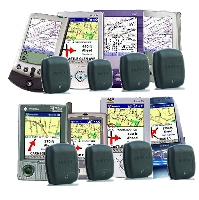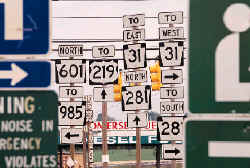With both CDMA and GSM now surpassing the billion devices landmark,
it is not just McDonalds that can boast of these stellar customer numbers.
No matter how you figure it, that is a lot of users. Most of the
new devices contain either GPS or some alternative form of location identification.
Given the rapid pace of obsolescence in this marketplace, this means that
there will soon be billions of location-aware devices in the hands of billions
of people worldwide.This will change the world. It also has profound
implications for geospatial data.

This week was the Tele Atlas (TA) Partner Conference. This is
an interesting gathering because it brings together representatives from
a broad spectrum of companies around the world. There is also a demonstrable
focus - the creation of practical, marketable products for the business
and consumer market, with an emphasis on navigation and location based
services. This is the third of these TA conferences that I have attended,
and I get the sense that much of the nascent theory and ideas that were
discussed in earlier conferences are rapidly becoming practical and real.
Nothing is successful before its time, but the time, perhaps, is upon us.
Several themes have been swirling about in the ether for years:
- Convergence
- Ubiquity
- Integration
- Personalization
Ubiquity is demonstrated by the fact that these devices are everywhere you look, and people expect them to work everywhere they go. Our kids have them, our parents and grandparents use them. Generation Y (currently 5-20 yrs old) cannot live without them. They have become an extension of ourselves. In part we need them because we have become so mobile; in part this mobility defines them. An in-car system, or an office system is very limited because you can't take it with you. To be effective, your permanent device must be small and convenient; so that you can take it virtually anywhere. If you also use more 'fixed' devices such as laptops, office computers, land-line phones, on-board car systems, they need to communicate automatically and seamlessly with the mobile device. We don't have the time, or the inclination, to actively connect or sync the devices. Nor should we have to.
Integration, as any of us in the spatial sciences can attest, is far more than simple connectivity. True integration implies compete interoperability; the ability to approach an activity or problem from any perspective and yet achieve the same experience. We want to interact with these devices in a natural and unconstrained way; much the way we interact with other people. They need to function effortlessly and seamlessly everywhere, and regardless of how we choose to communicate (voice, sight, touch, etc.).
Personalization is the ability to create and preserve a little of our own individual identity and personality in a mass-manufactured world.We don't want to be treated like everyone else. We want to be recognized as individuals with specific needs, likes and desires.We want these characteristics to be recognized and remembered by the technology that we use. This makes the devices more functional, but it also makes them more personable and comfortable.
The purpose of much of this technology is to provide information. But information is not useful if it is not the right information. The information that we need right at that moment, to solve our immediate problem. Not too much, not too little. Just the right amount for the job. The information I want, at this moment, in the way I want it and can most effectively use it.
The problem is not data. We are bombarded with data. The
cat has choked on data. We have too bloody much data.

The problem is how do we make sense of it. How do we sort through
the chaff to find the wheat?
This problem is self evident to anyone who has ever used a search engine or a navigation system, especially in unfamiliar territory. How many times have you queried a telephone lookup, or a business directory, or an Internet search engine, or a navigation system, only to be presented with hundreds of pages of data, most of which bears no correlation with the data you are seeking. Or alternatively, comes up with nothing, even though you know it exists. Some would say the problem is in the question. It was not specific enough. It was too specific. It was phrased incorrectly. The wrong town name was used. The question was ambiguous. Fine. But we should not have to adapt to the machine. The machine should adapt to us.
The answer lies in context. We use it all the time, as human beings. We discern, out of thousands of possible meanings, just what question a person is asking, and just what type of answer they are seeking, and how they want to receive the answer. Most of the time we do this very well. We are able to do this because we are able to apply context to the input, to eliminate a myriad of alternative interpretations of the query, and to hone in on the desired information. We use all of our senses to derive this context. Tone of voice, inflection, facial expression, where the conversation is taking place, the nature of the conversation, what was asked immediately before, the time of day, the day of week and a host of other cues help us to correctly interpret the question.
To date, context has been largely missing from automated systems. This is changing. For example, natural language interfaces are evolving which will allow us to hold a complex, natural conversation with a machine and have it understand us and provide appropriate responses back. Multi modal systems accept many different types of input: voice, touch screen, menu selection, typing, map input. While we are still years away from a fully functional solution, significant strides have been made in the ability of automated systems to tease out the key input data and provide effective and meaningful responses.
Location provides powerful context. By narrowing the zone of the query, the options are dramatically reduced. A primary clue as to how to interpret a question a person is asking is where they ask it. If you are driving along a freeway and ask for a gas station, you almost certainly mean the next one along that highway in the direction you are going. If you are looking for 24 Main St., it is far more likely to be one close to where you are than one several counties away. Spatial indexing, hierarchy and cross-referencing can be used to great advantage to both interpret the query and to filter the response. Effective use of high quality meta data is critical.
With the wide spread proliferation of location-aware mobile devices, and the dramatically increased need for location specific information driven by our increasingly mobile and time-constrained society, there has never been a greater need for spatially-referenced data. Indeed the availability of high quality spatially referenced data will become a major constraining factor in the effective use of mobile devices. We have our work cut out for us.